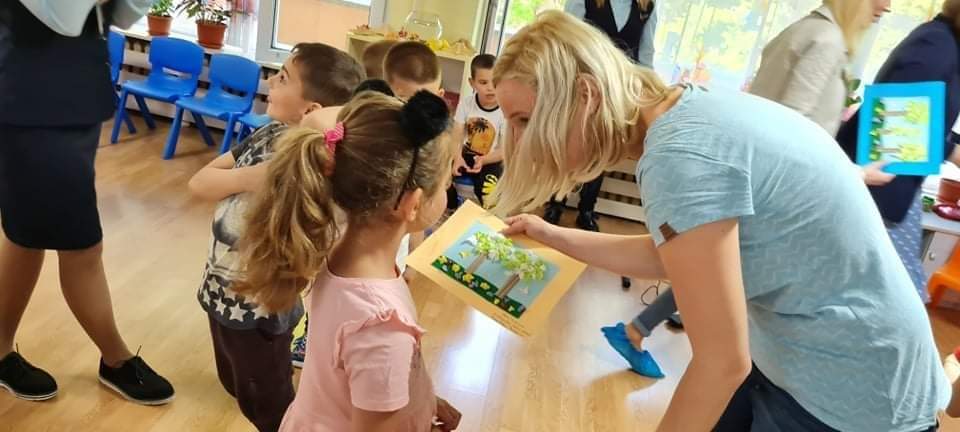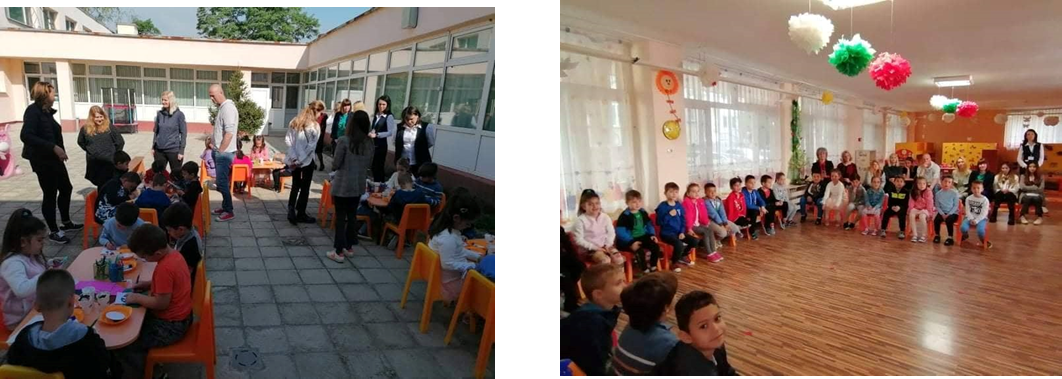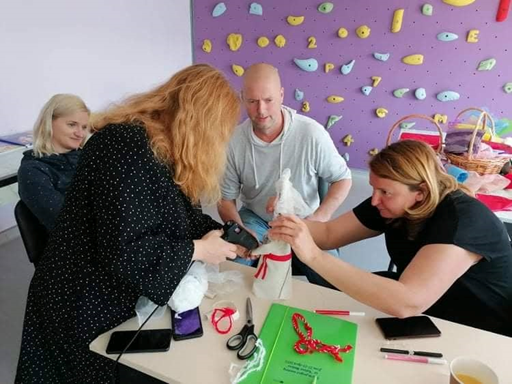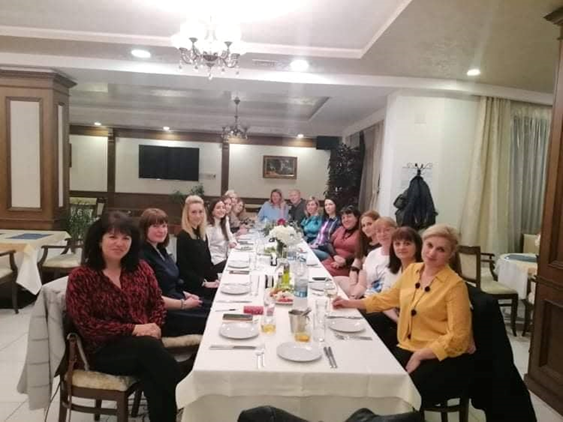Little footprints leave a small carbon footprint behind: LTT mobility in Bulgaria- Pazardzhik
Participants of the meeting are:
Latvia: Liga, Liana
Bulgaria: Ekaterina, Elena, Margarita, Kristina
Spain: Macu, Marina
Slovenia: Anja, Katja, Daniela, Vili
Day 1, April 27 2022
Introduction
Bulgarian coordinator Ekaterina met us in our hotel. All participants drove to the kindergarten Kalina Malina by car. At the kindergarten we were greeted by children who offered us some bread with honey or salt which is a Bulgarian tradition. They also welcomed us with flags and greetings in all project languages.

Headmistress took us to the common room and explained a bit about the kindergarten. 450 children are enrolled in the kindergarten. There are 12 groups in 2 buildings at this location and another 3 groups in a nearby village. All together they have 10 acres of land. Ekaterina presented the timeline and offered us coffee and tea. Project folders with materials were distributed.

Job-shadowing
Later on we visited different lessons.
First, we visited a group of 5-6 year old children called Golden fish. They showed us how they do music lessons. Children sang songs in Bulgarian and English, used instruments and showed us an activity done through the methodology of Schilwerk and Orff. They also did a movement activity where children identified vegetables and fruit. Next lesson was called Treasure Island and was designed for 6–7-year-olds. Children dressed as sailors went on a fantasy treasure hunt outdoors involving a sensory path, recycling, planting a tree and arranging fruits and vegetables in various designs. Movement activity called Following footprints of nature was next. Outdoors we were observing children who performed different movements in the shape of a circle, line and column. They also did an obstacle course. We walked around the kindergarten, visited different rooms and spaces (outdoor and indoor), including the nurse office, offices of school government and playgrounds. We were invited into nursery classes for the youngest children (2–3-year-old), who are taken care of by nurses and assistants. There are around 30 children in every class, no regards to their age.






 We had lunch where we were served the same courses as children. After lunch there was some free time to relax.
We had lunch where we were served the same courses as children. After lunch there was some free time to relax.

Afternoon presentation about the kindergarten
Headmistress with the help of a translator, explained about the organization and pedagogical approach of Kalina Malina kindergarten. Bulgarian kindergartens follow the national curriculum/standards that covers 7 areas of learning: language, math, nature and social sciences, art, music, construction and technology and physical education. They offer two types of program to the children - full time is from 7am to 7pm, but there is also a half day program offered for the year before elementary school - preschool.
In this kindergarten there is a program for 1-3 year olds (nursery) and for 3-7 year olds (kindergarten). There are age groups 3-4, 4-5, 5-6, 6-7 years. Second to fourth group is mandatory. After they finish kindergarten children get the certificate that they are ready for school.
Kindergarten routine:
- Morning exercise
- Breakfast
- Structured activities
- Optional activities based on play
- 12-12.30 pm: lunch
- 12.30 - 3pm: sleep time
After that there are some less structured activities, based on play, and are optional to join
There are different extracurricular activities offered for children, according to their interest. Parents have to pay for that as they are performed by outside organizations.
Everyday there are some obligatory activities and some optional ones. There is a curriculum that needs to be performed everyday so there is a lesson for every day. Every topic can be thought of in many ways – teachers can make a choice how they will teach it. One activity for kids from 3-5 year lasts for 20 min, and 30 minutes for kids from 5 -7 year old.
11min to 17 topics min (lessons) should be taught in a week, according to age group. Every kindergarten chooses the preferential/priority topics. Priority topic in Kalina Malina is art.
There are 60 members of staff: 30 teachers and 30 school government and technical staff (such as cleaners, cooks..)
There should be 12-25 children in class, but because of interest there are 5 more children in every class. Two teachers work in every class: one works from 7.30-12.30 and the other from 12.30-18.30. Teachers work with children for 6 hours, apart from nurses and assistants in the youngest age group. In every group there is additional assistant
All the teachers in the kindergarten graduated university for preschool education (4 years), some also have English language education. After a bachelor's degree teachers can do a master's degree in an additional pedagogical field. The greatest problem for teachers in kindergarten is paper work as there are a lot of reports and documentation.
They have electronic monitoring of the presence of children and activities, and there is also a written folder for documentation (for every child). There is also a class portfolio. In the oldest class teachers make a portfolio for every child with their achievements and accomplish goals that they give to parents. Parents should present this folder when they enroll a child into primary school.
Every school has a budget according to the number of students. Headmistress in charge of managing the budget. If there are more children, the principal can give bigger salaries to teachers. Teachers get additional money for work clothes. Transport costs are covered and also 50% for work mobile phones. There is some team building organized and teachers also get some extra money if there is left at the end of the school year.
Parents committee pays an extra 3-5 euros and decides what money will be spent. Tax for kids was 30-45 leva which parents paid. From April it is free for parents and paid by the government. Kindergarten is in 3 Erasmus projects and also in some national projects. National projects are in accordance with goals and themes of national standards. Projects are optional, Kalina Malina focuses on ecological themes, healthy lifestyle, art and social communication. Today the goal was to develop individual interests. Usually, parents pay around 9 euros for additional activities.
Parents pay for workbooks for 3–4-year-olds. For older groups they are covered by the government.
Special need children: They have special teachers and programs for special needs children, there should be no more than special need children in every class. More severe children attend special resource centers.


Day 2, April 28 2022
After the morning greeting we did a job shadowing activity with a group of children aged 6-7. We observed an activity called Happy Planet Earth. The children watched a short video about the consequences of pollution through a television projection. After the video, teacher showed the children a photo of how to make a flying balloon with a basket. Everything was also shown in the animation.

The activity itself was then carried out in the inner courtyard, where tables with material and a board with pictorial instructions were prepared in advance. While children did their craft activity, we were invited to tour the rest of the kindergarten.
During the tour, we observed special classroom arts, where they had wooden tables with painting stands. We also visited a room that was decorated in the style of an ethnological museum, with traditional furniture, art and everyday use items. They use the room for meetings with grandparents, reading folk tales, baking bread and the like. The kindergarten places great emphasis on tradition and homeland education.

We also visited a class where 4-5 year old children learned folk dance with a dance teacher. We took a look at a few other rooms, changing rooms, restrooms, and common areas. Each classroom has its own hall with a seating area, but they also have a small room where they disinfect and wash dishes, prepare snacks and distribute food. This is the work of a group helper who also makes the beds, prepares the materials and cleans.

This was followed by a team-building activity, where we made puppets in national groups in traditional costumes of partner countries. We used mostly waste material in the production. We donated the dolls to a Bulgarian kindergarten.

After lunch and a short break, we had a meeting with two representatives from Pazardzhik municipality, the director of the directorate for education and an expert in the field of pre-school education
We learned about the number of kindergartens, schools and high schools in their municipality. They explained which things are regulated at the state level and for which the municipality is responsible. They stressed that their main goal is to keep children who are educated at all levels in the municipality of Padzardzik. In the past, it happened to them that a large proportion of the population migrated to larger cities in their vicinity, but now this trend is reversing. People stay in the municipality and most of them find employment there. In the field of pre-school education, which has been compulsory since the age of four, their main goal is to ensure that children are well-brought up and well-educated.


We were also visited by a local television crew. They prepared news coverage about our visit. At the end of the meeting we were awarded with certificates and traditional Bulgarian gifts. This was followed by a photo shoot and a final evaluation. Each participant completed their own evaluation sheet.


Afternoon was dedicated to sightseeing. We went to see the ethnological museum, a traditional house from the 18th century and the archeological museum. We went on a short tour of the Orthodox Church. In the evening we all gathered together for traditional dinner. Third day of the project meeting was dedicated to individual sightseeing excursions.